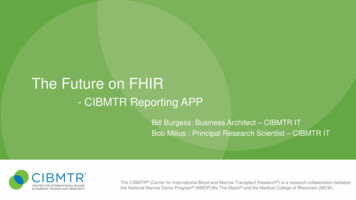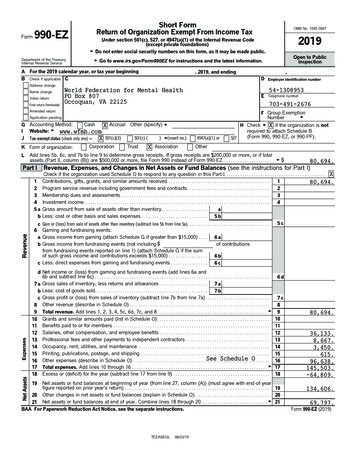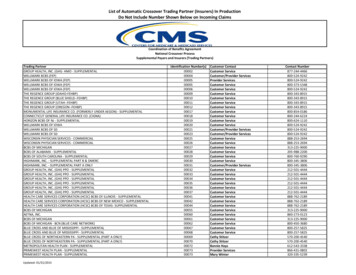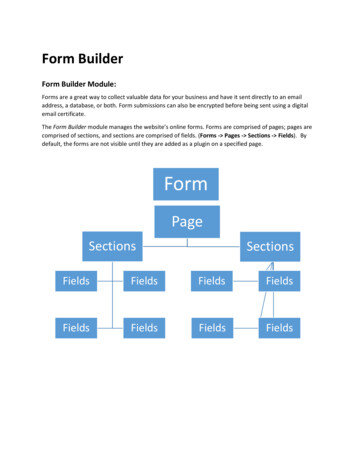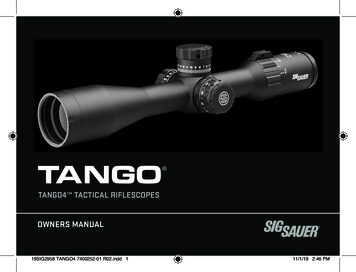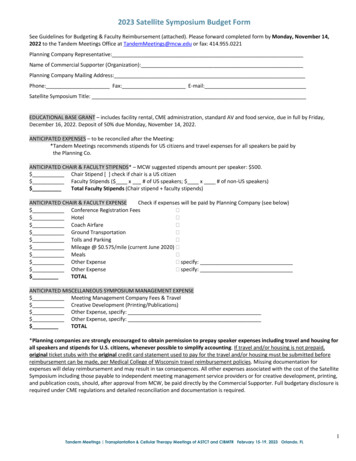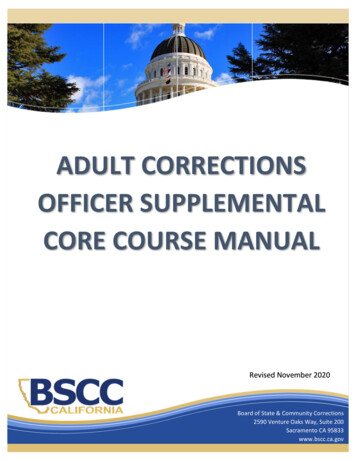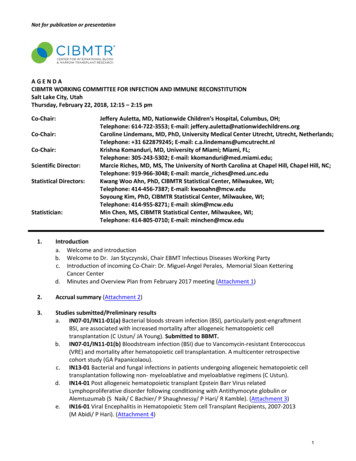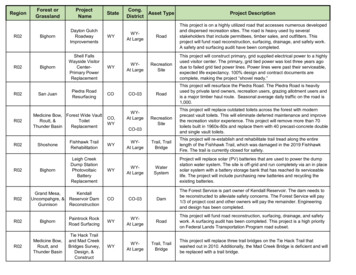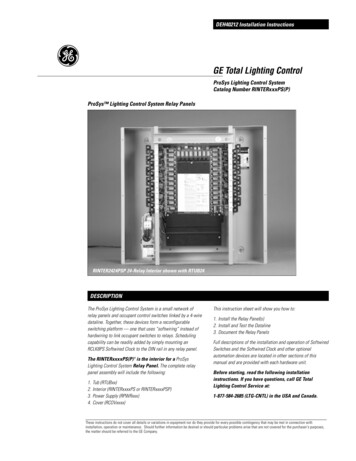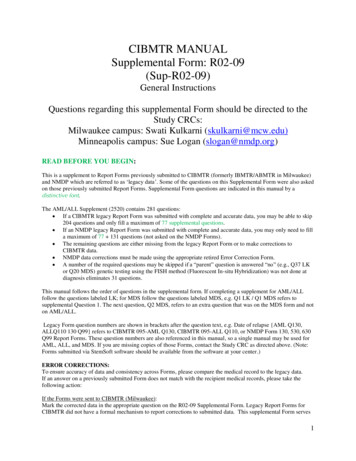
Transcription
CIBMTR MANUALSupplemental Form: R02-09(Sup-R02-09)General InstructionsQuestions regarding this supplemental Form should be directed to theStudy CRCs:Milwaukee campus: Swati Kulkarni (skulkarni@mcw.edu)Minneapolis campus: Sue Logan (slogan@nmdp.org)READ BEFORE YOU BEGIN:This is a supplement to Report Forms previously submitted to CIBMTR (formerly IBMTR/ABMTR in Milwaukee)and NMDP which are referred to as ‘legacy data’. Some of the questions on this Supplemental Form were also askedon those previously submitted Report Forms. Supplemental Form questions are indicated in this manual by a.The AML/ALL Supplement (2520) contains 281 questions: If a CIBMTR legacy Report Form was submitted with complete and accurate data, you may be able to skip204 questions and only fill a maximum of 77 supplemental questions. If an NMDP legacy Report Form was submitted with complete and accurate data, you may only need to filla maximum of 77 131 questions (not asked on the NMDP Forms). The remaining questions are either missing from the legacy Report Form or to make corrections toCIBMTR data. NMDP data corrections must be made using the appropriate retired Error Correction Form. A number of the required questions may be skipped if a “parent” question is answered “no” (e.g., Q37 LKor Q20 MDS) genetic testing using the FISH method (Fluorescent In-situ Hybridization) was not done atdiagnosis eliminates 31 questions.This manual follows the order of questions in the supplemental form. If completing a supplement for AML/ALLfollow the questions labeled LK; for MDS follow the questions labeled MDS, e.g. Q1 LK / Q1 MDS refers tosupplemental Question 1. The next question, Q2 MDS, refers to an extra question that was on the MDS form and noton AML/ALL.Legacy Form question numbers are shown in brackets after the question text, e.g. Date of relapse {AML Q130,ALLQ110 130 Q99} refers to CIBMTR 095-AML Q130, CIBMTR 095-ALL Q110, or NMDP Form 130, 530, 630Q99 Report Forms. These question numbers are also referenced in this manual, so a single manual may be used forAML, ALL, and MDS. If you are missing copies of those Forms, contact the Study CRC as directed above. (Note:Forms submitted via StemSoft software should be available from the software at your center.)ERROR CORRECTIONS:To ensure accuracy of data and consistency across Forms, please compare the medical record to the legacy data.If an answer on a previously submitted Form does not match with the recipient medical records, please take thefollowing action:If the Forms were sent to CIBMTR (Milwaukee):Mark the corrected data in the appropriate question on the R02-09 Supplemental Form. Legacy Report Forms forCIBMTR did not have a formal mechanism to report corrections to submitted data. This supplemental Form serves1
the purpose for making corrections to data included in this study. Also note that prior to the advent of a DCI ReportForm, the legacy transplant Report Forms were used to collect data on DCIs with the understanding that theprocedure was NOT a transplant, and would NOT be analyzed as such. When reading questions that use theterminology “conditioning” or “transplant” but the infusion was a DCI, substitute the phrase “just prior to infusion”for “conditioning” and substitute “DCI” for “transplant.”If the Forms were sent to NMDP (Minneapolis):Contact your center liaison or the Study CRC for an Error Correction Form (E.C.). Complete the E.C. Form thatcorresponds to the incorrect legacy data and submit it with the supplemental Form. Mail, fax, or E-mail the completedError Correction Form to your current CIBMTR campus.If you do not need to make corrections to the legacy data, skip to the supplemental data questions identified by aSome older versions of the NMDP forms did not collect some of the data that is marked on this supplemental form aspreviously submitted; in this case, please provide the data at this time in the indicated questions.If you have any special circumstances that are not addressed by these instructions, please contact the study CRC oryour center liaison. Abbreviations:CBC – Complete Blood Cell CountCRC – Clinical Research Coordinator (a.k.a. the Study CRCs or your CIBMTR liaison)DCI – Donor Cellular Infusion (various cell sub-types)DLI – Donor Lymphocyte (or Leukocyte) Infusion (usually T cells)E.C. – NMDP Error Correction FormFISH – Fluorescent in situ HybridizationGVHD – Graft-versus-Host-DiseaseHSCT – Hematopoietic Stem Cell TransplantPBSC – Peripheral Blood Stem CellPCR – Polymerase Chain ReactionSup – This Supplemental Report FormWBC – White Blood Cell CIBMTRCenter #:Enter the five-digit CIBMTR Center Number (CCN). The CCN replaced the three-digit CIBMTR Team number andthree-digit NMDP TC code in December 2007 for data submission in the FormsNet2 system. CRID:The CIBMTR Recipient Identification (CRID) number is a lifelong ID assigned by CIBMTR to each recipient. It isgenerated by submitting the CRID Form (2804) prior to the recipient’s first HSCT. Recipients in the CIBMTR orNMDP databases as of December 2, 2007, have been assigned a CRID number by CIBMTR. 2
DATA ELEMENT:RecipientNMDP ID:DIRECTIVE(S):The Recipient IDentification (RID) number is assigned by NMDP. If you do not knowthe recipient’s ID number, please contact the Study CRCs. If the HSCT was notfacilitated by NMDP, leave this field blank.–– DATA ELEMENT:NMDPTC Code:DIRECTIVE(S):The Transplant Center (TC) Code is assigned by NMDP. If you do not know yourCenter’s TC code, please contact the Study CRCs. If the HSCT was not facilitated byNMDP, leave this field blank. DATA ELEMENT:Recipient Local ID (NMDP only):DIRECTIVE(S):This ID number is assigned by your Center for your own tracking purposes; you mayleave this field blank. If the HSCT was not facilitated by NMDP, leave this field blank. DATA ELEMENT:CIBMTRTeam:DIRECTIVE(S):The Team Number is assigned by CIBMTR. If you do not know your Center’s Teamnumber, please contact the Study CRCs. DATA ELEMENT:CIBMTRIUBMID:Institutional unique blood or marrow transplant ID numberDIRECTIVE(S):The IUBMID Number is assigned by your Center to uniquely identify your recipient andmust be HIPAA compliant. For more information regarding assigning IUBMIDnumbers, please refer gReference/Manuals/Retired/Documents/CIBMTR Reg s/section7.pdf DATA ELEMENT:2 0Today’s Date:MonthDIRECTIVE(S):DayYearThe date this document is complete and checked for accuracy. CIBMTR: formerly knownas Date of Report. 3
DATA ELEMENT:Date of HSCT for which this form isbeing completed:DIRECTIVE(S):MonthDayYearDate of HSCT should reflect the date of HSCT #1 (a.k.a. transplant #1). DATA ELEMENT:CIBMTR Use OnlySequenceNumber:DIRECTIVE(S):Leave these fields blank. DATA ELEMENT:DateReceived:DIRECTIVE(S):The date that Sup-R02-09 arrives at CIBMTR (your assigned campus). Leave this fieldblank. DATA ELEMENT:Form IDNumber:DIRECTIVE(S):The Form ID is assigned by CIBMTR for Form tracking purposes. Leave this field blankunless you are certain what Form ID was assigned to your recipient by CIBMTR. If theHSCT was facilitated by NMDP, leave this field blank.– 4
Timeline Information for the Study DataAll questions in the Post-Hematopoietic Stem Cell Transplant (HSCT) section refer to the first relapse after therecipient’s first HSCT. The data was possibly submitted on a legacy Report Form from CIBMTR or NMDP, ratherthan in the FormsNet2 system. If that is the case, in the legacy system CIBMTR (prior to December 3, 2007)requested that a subsequent HSCT Form or DCI Report Form be completed when a DCI (e.g. DLI) was performed.This supplement integrates the Form questions from the legacy system in order to link potentially existing data tothe supplemental data needed at this time. If the legacy data was never submitted, it is now required for this study.The R02-09 Supplemental Form contains two “Post” evaluations. The first is from Post-HSCT #1 at the time thepost-HSCT relapse occurred. The second “Post” evaluation at the end of the Supplemental Form is from the periodof time after the DCI/DLI. The way DCI data is collected in FormsNet2 is different. If you have any questions aboutcompleting this study request, please do not hesitate to ask.The following link to the legacy CIBMTR Core Insert provides instructions regarding what Forms were to becompleted when a DCI/DLI was given to a recipient post-HSCT. Go to Core Insert p16, Q318 to view timelinediagrams. This may orient you as to which Forms may have been completed for the ?dcfid 154DIRECTIVE(S):Recipient medical record should match any previously submitted data from 095-AML, 095ALL, 095-AMLFU, 095-ALLFU, NMDP Form 130, 530, 630, NMDP Form 140, NMDP Form 150 for HSCT #1.Sup-R02-09QuestionsstDate of 1 postHSCT#1 RelapseBone MarrowCNSTestesOtherTherapyChemoDLI*Growth FactorsImmunotoxinInterferon αInterferon βSecond HSCT*Withdrawal ofImmuneSuppressionOtherCr achieved?*Current statuspost DCI #1 095-AMLquestion #s095-AMLFUquestion #s095-ALLquestion #s095-MDSquestion #sNMDP 130question #sNMDP 140question #sThese data are after the HSCT #1 at the time of relapse, but before the 7125These data are after the DCI/DLI:12911129109-102h-97h-1069893*Although DCI/DLI and subsequent HSCT are listed in the options for treatment of the post-HSCT relapse, there wasan important reporting caveat at the time those Forms were in effect. The caveat was to cut off the data for the ReportForm for either of those specific treatments, at one day prior to a preparative regimen (if given) or one day prior to theinfusion (if no prep. regimen used). So, the response from a DCI or subsequent HSCT would NOT be reflected on theReport Form in which it was first reported. The Forms were to ‘start over’ and it was on that new set of Forms that theresponse to DCI or subsequent HSCT would be captured.5
Pre-HSCT #1 Information Note: R02-09 LK Q1-91 and R02-09 MDS Q1-55The time frame listed for these questions is pre-HSCT #1, “at diagnosis” or “preconditioning”, and are accurate.Study R02-09 will compare abnormalities present prior to the first HSCT with those present at first relapse postHSCT. These questions are the only ones referring to pre-HSCT data. When answering these questions take care tonote the time frame of the documents in the recipient’s medical record. Q1 LK/Q1 MDS:Were cytogenetics tested at diagnosis, before the start of treatment? {AML Q28} {ALLQ10} {MDS Q26} {120-Insert I, Q18} {120-Insert II, Q9} {120-Insert V, Q26}DEFINITION:Cytogenetic tests look at chromosomes in the cells, typically about 20 cells, forabnormalities. FISH (Fluorescent in situ Hybridization) is a method of looking for the sameabnormality in typically 200-500 cells, but via a fluorescent tag on the corresponding gene.FISH was reported in the cytogenetic section of the legacy Forms, not molecular, as thelevel of sensitivity is closer to that of cytogenetics than other molecular tests. Thissupplement separates the collection of conventional cytogenetics from FISH at diagnosis. Iftesting was done via FISH. This sectionwill compare the results from diagnosis with the results of testing at relapse. See the tablebelow for examples of common cytogenetic abnormalities:Disease Form/Questions FormsNet version forms:AMLForm ctionForms/Documents/2010/Rev1.Q28-550/combine 2010 AML.pdfALLForm 1%20ALL%20r2.pdfMDSForm aCollectionForms/Documents/2014/Rev1.0/combine 2014 MDS.pdfDIRECTIVE(S):Indicate whether cytogenetic testing was performed. Q2 or Q20 LKQ2 MDS:DIRECTIVE(S):If results were 46, XX for a female recipient or 46, XY for a male; answer ‘noabnormalities’. If not normal, ‘yes, abnormalities identified’, unless the abnormality wasrandom (only 1 copy). If the cells were not able to divide, the result comes back ‘noevaluable metaphases’. 6
Q3-19 or Q21-36 LK/Q3-19 MDS:Specify abnormalities: {AML Q31-45} {ALL Q13-26} {MDS Q29-44}{120-Insert I, Q21a-d}{120-Insert II, Q12a-f} {120-Insert V, Q29a-o}DEFINITION:Under the microscope a chromosome looks a lot like the letter X. The top half of thechromosome (X) is known as the short arms and is designated by the letter ‘p’ (forpetite). The bottom is known as the long arms and is designated by the letter ‘q’.Abnormalities may involve the entire chromosome, either missing (monosomy) orduplicated (trisomy). If a portion of the chromosome is defective it is a structuralabnormality.An entire missing chromosome (monosomy) and deletion from an arm of a chromosomemay be collected in the same question for the same chromosome, e.g. Q15 ‘-5’ representsmonosomy 5, a missing chromosome 5. “5q-“ represents the deletion of material from the qarm of chromosome 5 (may also appear as del(5q)).An abnormal 3q, 11q, 16q includes any type of abnormality involving the q arm of thespecified chromosomes.Translocation, designated by “t”, indicates that a piece of an arm from one chromosomebroke off and reattached to another chromosome. When 2 sets of parenthesis describe thetranslocation, the first set identifies the chromosome numbers; the second set shows thebreakpoints. CIBMTR Forms do not collect the breakpoint region; do not report these in“other” (e.g. t(9;22)(q34;q11): the translocation is between chromosome 9 & 22. Thebreakpoints are q34 and q11 and are not reported to CIBMTR.Do not confuse chromosome number with breakpoint region. The chromosome is alwaysindicated before the chromosome arm (p or q), and the breakpoints are given after the arm.For more detailed information on reporting cytogenetics, see the presentation by WillisNavarro, MD, at the Clinical Research Professionals Data Management Conference duringthe 2010 BMT Tandem CRPDMC/Pages/feb10Navarro2.aspxDIRECTIVE(S):If the recipient was transplanted for AML, use Q15-31; for ALL use Q33-48; for MDS useq19-35 to report conventional cytogenetic testing results. Q37-69 LK /Q20-38 MDS:?DEFINITION:FISH (Fluorescent in situ Hybridization) is a method of looking for the same abnormality(as conventional cytogenetics) in typically 200-500 cells, but via a fluorescent tag on thecorresponding gene. FISH was reported in the cytogenetic section of the legacy Forms, notmolecular, as the level of sensitivity is closer to that of cytogenetics than other moleculartests. This supplement separates the collection of conventional cytogenetics from FISH atdiagnosis. If testing was done via FISH.This section will compare the results from diagnosis with the results of testing at relapse.DIRECTIVE(S):If abnormalities were identified at diagnosis via FISH, report the specifics in Q50-81 LK/ 37-54 MDS. See details at Q14. 7
Q70-91 LK/Q39-55 MDS:Were tests (e.g., PCR) for BCR/ABL or other molecular markers done at any time prior toconditioning?{ALL Q60}.DEFINITION:Molecular testing is a very sensitive PCR test that can detect up to 1 cell in 10 5 or 106;it is much more sensitive than cytogenetics or FISH. This question will compare the resultsfrom diagnosis with the results of testing at relapse.The CIBMTR legacy ALL Disease Insert had a few specific molecular testing questions,AML/MDS did not. If molecular testing was done for AML/MDS, this question isconsidered supplemental and must be completed.DIRECTIVE(S):Indicate whether molecular testing was performed. If yes, also provide the results. Theknown genetic markers for MDS/Leukemia are given. If your markers do not match,check for a typo on the report. Post-HSCT InformationFORM ABBREVIATION KEYThese data correlate to the Report Form that documented the first Post-HSCT #1 relapse.Correcting data from:AML 095-AML p7, Qs.129-134, or 095-AMLFU p1-2, Qs.11-16, go to Sup Q.92-99.ALL 095-ALL p6, Qs.109-114, or 095-ALLFU p1-2, Qs.11-16, go to Sup Q.92-99.MDS 095-MDS p7, Qs.106-110 or 095-MDS-FU p1, Qs.5-6 go to Sup Qs.56-61, 63.130 NMDP Form 130,530,630 p11, Qs.99-100, submit E.C. Form and go to Sup Qs by disease as above.NMDP Form 140,540,640 p11, Qs.94-95, submit E.C. Form and go to Sup Qs by disease as above.NMDP Form 150,550,650 p6, Q.35, submit E.C. Form and go to Sup Qs by disease as above.If not correcting data, go to Q92 LK / Q56 MDS:Did the disease (AML or ALL) (MDS) relapse post-HSCT #1?DEFINITION:Remission criteria:1. Morphologic (hematologic) remission less than 5% blasts with normal cellularity andnormal CBC2. Cytogenetic remission: normal cytogenetics (diploid)3. Molecular remission: undetectable (if applicable)DIRECTIVE(S):All must meet the morphologic (hematologic) criteria for CR and then relapse post-HSCT#1. If the recipient was never in CR post-HSCT, they cannot be reported as having a relapsewithout an explanation.Answer should match any previously submitted data from 095-AML or NMDP follow-upforms regarding disease relapse after HSCT #1, date of (post-HSCT) relapse, and site/s ofrelapse corresponding to that date. For more detailed instructions regarding how to makecorrections, refer to the general instructions at the beginning of this document.Answer option #2, yes, therapy-induced complete remission after persistent or recurrentleukemia posttransplant, requires some thought. This option applies at this time point onlyif the remission was achieved with therapy not including a DCI/DLI or subsequent HSCT.Depending on when the legacy Report Form was cut off, this answer may needmodification in order for the recipient to remain in the study. If the only therapy given for8
the relapse was DCI, use option 3, ‘yes’ relapse or persistent disease. The remissionachieved by the DCI will be collected at the end of this supplement. Q57 MDS:Most recent posttransplant disease status {MDS Q106} {130 Q98} (refers to relapsepost-HSCT #1):DEFINITION:Remission criteria:1. Morphologic (hematologic) remission less than 5% blasts with normal cellularity andnormal CBC2. Cytogenetic remission: normal cytogenetics (diploid)3. Molecular remission: undetectable (if applicable)DIRECTIVE(S):All must meet the morphologic (hematologic) criteria for CR and then relapse post-HSCT#1. If the recipient was never in CR post-HSCT, they cannot be reported as having a relapsewithout an explanation.Answer should match any previously submitted data from 095-MDS or NMDP follow-upforms regarding disease relapse after HSCT #1, date of (post-HSCT) relapse, and site/s ofrelapse corresponding to that date. For more detailed instructions regarding how to makecorrections, refer to the general instructions at the beginning of this document.1[] Relapse2[] Complete remission after posttransplant relapseAnswer option #2, requires some thought. This option applies at this time point only ifthe remission was achieved with therapy not including a DCI/DLI or subsequent HSCT.Depending on when the legacy Report Form was cut off, this answer may needmodification in order for the recipient to remain in the study. If the only therapy given forthe relapse was DCI, use option 1, yes, relapse. The remission achieved by the DCI willbe collected at the end of this supplement. Q93 LK /Q58 or 59 MDS:Date of relapse {AML Q130} {ALL Q110} {MDS Q107 or 108} {130 Q99}DEFINITION:Date of relapse usually corresponds to the first date a bone marrow biopsy was performedthat meets the criteria of 5% blasts with abnormal cellularity and /or an abnormal CBC. Ifother sites were involved, report as appropriate.DIRECTIVE(S):If multiple dates appear on the biopsy report, note the date the biopsy was performed, notthe date the lab ran the test or the document was dictated or transcribed. If the date isdocumented in correspondence from another physician and the precise date is not given,please estimate the date according to the information provided, e.g. ‘day’ is not given; usethe day ‘15’ as long as it chronologically fits with other known dates such as therapystart/stop dates, etc. Q60-61 MDS:Treatment given {MDS Q109} NOTE: Report in Sup R02-09MDS Qs78-97Date of remission {MDS Q110} MM-DD-YYYYDIRECTIVE(S):If answer option #2 is selected for MDS Q2, these two additional questions apply. Reportthe treatment given to achieve the CR in supplemental questions 78-97. Also include thedate CR was achieved as long as it was not achieved due to a DCI/DLI or subsequentHSCT.9
Site of recurrent AML or ALL or MDS:Q94 LK / Q62 MDS:Bone marrow {AML Q131} {ALL Q111} {130 Q100a}DIRECTIVE(S):If the bone marrow biopsy meets the criteria of 5% blasts with abnormal cellularity and/or an abnormal CBC (including peripheral blood), select ‘yes’. Q63 MDSBlasts in marrow {MDS Q115}DIRECTIVE(S):From the bone marrow report, indicate the percentage of blasts in the marrow at relapse.If the ‘most recent test’ captured the relapse at the time of the report, {MDS Q115} mayindicate the percentage of blasts at relapse. If the ‘most recent test’ occurred after therelapse, then report the percentage of blasts at the time of relapse in this supplement; thedata will not match what was reported in {MDS Q115}. Q95 LK / Q64 MDS:CNS (Central Nervous System) {AML Q132} {ALL Q112} {130 Q100b}DEFINITION:Leukemia may be detected in Cerebral Spinal Fluid (CSF) or the brain.DIRECTIVE(S):If leukemic cells are found in the CNS, indicate ‘yes’. Q96 LK:Testes {AML Q133} {ALL Q113} {130 Q100c}DIRECTIVE(S):If leukemic cells are found in the testes, indicate ‘yes’. Q97-99 LK/Q65-67 MDS:Other / Specify {AML Q134} {ALL Q114} {130 Q100d}DIRECTIVE(S):If disease is detected somewhere other than the marrow, blood, CNS, or testes, report here., but do not also report on the ‘specify’line (text field). Studies obtained from peripheral blood or marrow at time of relapse post-HSCT #1 (Supplemental Form questions):Q100 LK/Q68 MDSDEFINITION:Flow cytometry measures the characteristics of the cells as they pass a laser beam thatdetects markers on the cellsDIRECTIVE(S):Indicate whether flow cytometry was performed. If yes, also provide the results. Q101-103 LK/Q69-71 MDSDEFINITION:Flow cytometry was tested in either bone marrow, peripheral blood, or both.10
DIRECTIVE(S):Indicate the results. Negative, or if at least one source was positive, report the percentageof positive cells, or not tested as applicable. Q104-105 LK/Q72-73 MDS:DEFINITION:Conventional cytogenetics were tested at the first relapse of MDS/Leukemia that occurredafter HSCT #1.DIRECTIVE(S):Comparing the 1st relapse cytogenetics to those tested at diagnosis, select the result thatapplies. Either abnormalities found at first relapse were the same, were different, there wereno metaphases to evaluate, or there were no cytogenetic abnormalities found (46, XX or 46,XY). Q106-107 LK/Q74-75 MDS:DEFINITION:FISH was done at the first relapse of MDS/Leukemia that occurred after HSCT #1.DIRECTIVE(S):Comparing the 1st relapse FISH results to those tested at diagnosis, select the answer thatapplies. Either abnormalities found at first relapse were the same, were different, there wereno cells to evaluate, or there were no markers found. Q108-109 LK/Q76-77 MDS:DEFINITION:PCR was done at the first relapse of MDS/Leukemia that occurred after HSCT #1.DIRECTIVE(S):Comparing the 1st relapse PCR results to those tested at diagnosis, select the answer thatapplies. Either abnormalities found at first relapse were the same, were different, there wereno cells to evaluate, or there were no markers found. FORM ABBREVIATION KEYCorrecting data fromAML 095-AML p7, Qs.135-145, or 095-AMLFU p1-2, Qs.17-27 go to Sup Q.112-116, 121, 125.ALL 095-ALL p6,Qs.115-12 or 095-ALLFU p1-2, Qs.17-27 go to Sup Q.112-116, 121, 125.MDS 095-MDS p7, Qs.109-110 or 095-MDS-FU p1, Qs.5-6 go to Sup Q80-84, 89, 93, 97.130 NMDP Form 130,530,630 p11, Qs.101-102 submit E.C. Form and go to Sup Q. by disease as above.NMDP Form 140,540,640 p11, Qs.96-97 submit E.C. Form and go to Sup Q. by disease as above.NMDP Form 150,550,650 p6, Q.35submit E.C. Form and go to Sup Q. by disease as above.If not correcting data, go to 11
Q110 LK /Was therapy given after this post-transplant relapse (but before DCI/DLI)?Q78 MDS:{AML Q135} {ALL Q115} {MDS Q109} {130 Q101}DIRECTIVE(S):If the relapse was treated, indicate the therapy used. In order to qualify for this study, aDCI/DLI must have been used. Q111-116 LK/Q79-84 MDS:Chemotherapy {AML Q138} {ALL Q118} {MDS Q109} {130 Q102b}DEFINITION:Three subsets of chemotherapy have been described: “common”chemotherapy,DIRECTIVE(S):If chemotherapy was used, also indicate which subtype.Table 1 Q17 Common systemic therapy for AML with alternate drug namesTretinoinall-trans retinoic acidATRAVesanoid(r)cytarabinecytosine sgemtuzumabMylotargIdarubicinIdamycinintrathecal tecanHycamtinSystemic therapy notCheck alternate therapy names first. Print neatlylisted aboveon the blank line**Note: The term intrathecal refers to a route of administration of therapy, not the drugs themselves. Typically Ara-C,MTX and/or hydrocortisone were used and should be reported here if administered intrathecally, not systemically. Q117 LK /Q85 MDS:Donor leukocytes {AML Q141} {ALL Q121} {MDS Q109} {130 Q102e}DEFINITION:The purpose of DLI therapy is to elicit an immune response via T cells. There may be othertypes of cells present in the infusion (e.g., a saved bag of cells from the original HSCTcollection), but it is critical that the purpose of the infusion was not to repopulate themarrow as in HSCT.What is not intuitive here is that if DCI/DLI was used to treat the relapse, the Form firstreporting DCI/DLI was to be cut off one day prior to the DCI/DLI and a new set of Formssubmitted. Therefore, the results from the DCI/DLI would be included in that new set ofForms for cases reported in the CIBMTR legacy system, not NMDP. (Refer to theinstructions at the beginning of the Post-HSCT section above for more details.)DIRECTIVE(S):Yes indicates a leukocyte or lymphocyte infusion to treat relapse. 12
Q118-119 LK/Q86-87 MDS:Growth factors {AML Q143} {ALL Q123} {MDS Q109} {130 Q102g}DIRECTIVE(S):Yes indicates growth factors (e.g. G-CSF, GM-CSF, IL-3) were part of the strategy to treatrelapse. Q120-121 LK/Q88-89 MDS:Immunotoxins {AML Q140} {ALL Q120} {MDS Q109} {130 Q102d}.DEFINITION:Immunotoxins are an alternate name for immunotherapy. There are two main types ofimmunotherapy. Active immunotherapies stimulate the body's own immune system tofight the disease. Passive immunotherapies do not rely on the body to attack the disease;instead, they use immune system components (such as antibodies) made in the lab.Examples include: DIRECTIVE(S):monoclonal antibodies (passive immunotherapies)canc
Center's TC code, please contact the Study CRCs. If the HSCT was not facilitated by . Chemo 138 20 118 109 102b 97b . at one day prior to a preparative regimen (if given) or one day prior to the infusion (if no prep. regimen used). So, the response from a DCI or subsequent HSCT would NOT be reflected on the .
